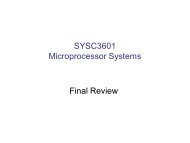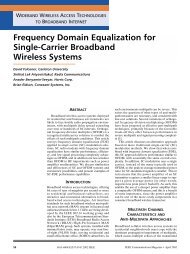Image Reconstruction for 3D Lung Imaging - Department of Systems ...
Image Reconstruction for 3D Lung Imaging - Department of Systems ...
Image Reconstruction for 3D Lung Imaging - Department of Systems ...
Create successful ePaper yourself
Turn your PDF publications into a flip-book with our unique Google optimized e-Paper software.
Chapter 8<br />
Conclusion and Future Work<br />
At the start <strong>of</strong> this work the prevailing algorithms in use <strong>for</strong> lung/chest imaging were limited<br />
to 2D models that relied on ad hoc tweaking to produce reconstructions. The aim <strong>of</strong> this<br />
thesis was to develop enhancements in EIT image reconstruction <strong>for</strong> <strong>3D</strong> lung imaging; in<br />
other words, to remove some <strong>of</strong> the limitations that continue to impede the routine use <strong>of</strong> <strong>3D</strong><br />
models <strong>for</strong> lung imaging. Due to our desire to validate theoretical and simulated models with<br />
lab data we constrained our field <strong>of</strong> investigation to models that could be realized with a 16<br />
electrode scanner designed <strong>for</strong> tetrapolar (ostensibly adjacent drive protocol) measurements<br />
in a 2D configuration. This required the application <strong>of</strong> engineering principles to develop<br />
and analyze reconstruction algorithms and protocols suitable <strong>for</strong> use with the 16 electrode<br />
EIT systems such as the Goe-MF Type II scanner.<br />
The aim was attained through the systematic achievement <strong>of</strong> the four main objectives:<br />
1. The development <strong>of</strong> the BestRes objective hyperparameter selection method provides<br />
a calibration based method <strong>of</strong> calculating a hyperparameter once <strong>for</strong> a specific configuration<br />
<strong>of</strong> mesh and equipment. Using this algorithm eliminates the necessity <strong>of</strong><br />
ad hoc tweaking by users during reconstruction. Disparate researchers can now more<br />
easily repeat the work <strong>of</strong> others. Moreover, by calculating the hyperparameter <strong>of</strong>f-line,<br />
a good image can be obtained from a single matrix inversion. Contrarily, methods<br />
such as L-curve and expert selection require multiple inversions to be calculated <strong>for</strong><br />
each useful solution. Moreover the L-Curve method is shown to be unreliable <strong>for</strong> EIT.<br />
2. The development <strong>of</strong> the Nodal Jacobian Inverse Solver algorithm enables the solution<br />
<strong>of</strong> large dense <strong>3D</strong> finite element models that, previous to this work, were not easily<br />
solvable using linear algebra systems based on 32 bit pointers. This solver allows<br />
one to model and solve complex, accurate geometries containing a priori structures<br />
with linear algebra s<strong>of</strong>tware that could not solve the same model using the traditional<br />
elemental Jacobian.<br />
3. The evaluation <strong>of</strong> an admittedly small set <strong>of</strong> potential <strong>3D</strong> EP configurations, nevertheless<br />
provides a sound basis <strong>for</strong> recommending a specific method to collect <strong>3D</strong><br />
lung data. Moreover it provides a firm basis to discontinue further evaluation <strong>of</strong><br />
configurations that per<strong>for</strong>m poorly, such as the proposed opposite configurations.<br />
4. The convergence improvements and subsequent evaluation <strong>of</strong> the PD-IPM algorithm<br />
<strong>for</strong> TV regularization provide a defensible argument <strong>for</strong> when and when not to use TV<br />
regularization. Moreover the promising 2D results provide justification and incentive<br />
<strong>for</strong> further research into this algorithm aimed at increasing the size <strong>of</strong> <strong>3D</strong> models that<br />
115





